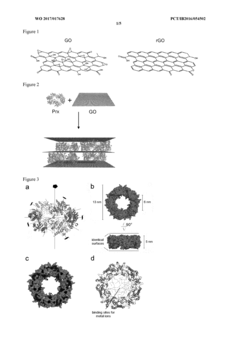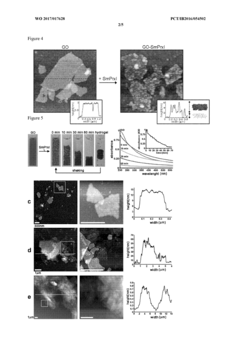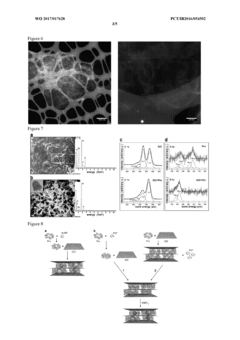Harnessing Graphene Oxide in Aerospace Applications
Graphene Oxide in Aerospace: Background and Objectives
Graphene oxide, a derivative of graphene, has emerged as a revolutionary material with immense potential in aerospace applications. This two-dimensional carbon-based nanomaterial possesses exceptional mechanical, thermal, and electrical properties, making it an attractive candidate for various aerospace components and systems. The development of graphene oxide technology has been driven by the aerospace industry's constant pursuit of lighter, stronger, and more efficient materials to enhance aircraft performance and reduce fuel consumption.
The evolution of graphene oxide in aerospace can be traced back to the early 2000s when researchers first began exploring its unique properties. Initially, the focus was on understanding the material's fundamental characteristics and developing synthesis methods. As the technology progressed, scientists and engineers started to investigate its potential applications in aerospace, ranging from structural reinforcement to thermal management and energy storage.
The primary objective of harnessing graphene oxide in aerospace applications is to leverage its extraordinary properties to address key challenges in the industry. These challenges include weight reduction, improved strength-to-weight ratios, enhanced thermal management, and increased electrical conductivity. By incorporating graphene oxide into aerospace materials and systems, researchers aim to develop next-generation aircraft that are more fuel-efficient, environmentally friendly, and capable of withstanding extreme conditions.
One of the most promising areas for graphene oxide application is in composite materials. By integrating graphene oxide into polymer matrices, researchers have demonstrated significant improvements in mechanical strength, stiffness, and impact resistance. This has led to the development of lightweight yet robust structural components for aircraft, potentially reducing overall weight and improving fuel efficiency.
Another critical objective is to exploit graphene oxide's thermal properties for advanced heat management systems in aerospace vehicles. The material's high thermal conductivity and stability make it an excellent candidate for developing more efficient heat exchangers and thermal interface materials, crucial for maintaining optimal operating temperatures in aircraft engines and electronic systems.
Furthermore, the aerospace industry is exploring graphene oxide's potential in energy storage and conversion applications. The material's high surface area and electrical conductivity make it promising for developing advanced batteries and supercapacitors, which could lead to more efficient and lightweight power systems for aircraft and spacecraft.
As research in this field continues to advance, the aerospace industry anticipates that graphene oxide-based technologies will play a pivotal role in shaping the future of aviation and space exploration. The ongoing efforts to harness graphene oxide's unique properties are expected to result in breakthrough innovations that will revolutionize aerospace design, performance, and sustainability in the coming decades.
Market Demand Analysis for Aerospace Materials
The aerospace industry is experiencing a growing demand for advanced materials that can enhance the performance, efficiency, and sustainability of aircraft and spacecraft. Graphene oxide, a derivative of graphene, has emerged as a promising candidate for various aerospace applications due to its exceptional properties. The market for aerospace materials is projected to expand significantly in the coming years, driven by increasing air travel, space exploration initiatives, and the need for more fuel-efficient and environmentally friendly transportation solutions.
In the commercial aviation sector, there is a strong demand for lightweight materials that can reduce fuel consumption and emissions. Graphene oxide-based composites offer potential weight savings while maintaining or improving structural integrity. This aligns with the industry's goal of developing more sustainable aircraft and meeting stringent environmental regulations. The military aerospace sector also shows interest in graphene oxide for its potential to enhance the stealth capabilities and durability of military aircraft and satellites.
The space exploration market presents another significant opportunity for graphene oxide applications. As space agencies and private companies intensify their efforts to explore and commercialize space, there is a growing need for materials that can withstand extreme conditions while minimizing payload weight. Graphene oxide's thermal and radiation-resistant properties make it an attractive option for spacecraft components and protective coatings.
The demand for graphene oxide in aerospace is further fueled by the increasing focus on electric and hybrid-electric aircraft. These next-generation aircraft require advanced energy storage solutions, where graphene oxide-enhanced batteries and supercapacitors could play a crucial role in improving energy density and charging capabilities.
Market analysis indicates that the aerospace materials market is expected to grow at a compound annual growth rate (CAGR) of over 6% in the next five years. While traditional materials like aluminum alloys and carbon fiber composites still dominate the market, novel materials such as graphene oxide are gaining traction. The potential market size for graphene oxide in aerospace applications is estimated to reach several hundred million dollars by 2030, with significant growth potential beyond that timeframe.
However, the adoption of graphene oxide in aerospace faces challenges related to scalability, cost-effectiveness, and regulatory approval. The industry's stringent safety standards and long certification processes can slow down the integration of new materials. Despite these hurdles, ongoing research and development efforts, coupled with successful demonstration projects, are gradually paving the way for increased adoption of graphene oxide in aerospace applications.
Current Challenges in Graphene Oxide Aerospace Integration
Despite the promising potential of graphene oxide in aerospace applications, several significant challenges currently hinder its widespread integration. One of the primary obstacles is the scalability of production processes. While laboratory-scale synthesis of high-quality graphene oxide is well-established, translating these methods to industrial-scale production while maintaining consistent quality and properties remains a formidable task.
Another critical challenge lies in the mechanical properties of graphene oxide-based composites. Although graphene oxide exhibits exceptional strength and flexibility on its own, incorporating it into aerospace materials without compromising the overall structural integrity of the composite is complex. Issues such as poor interfacial bonding between graphene oxide and matrix materials can lead to reduced mechanical performance in the final product.
The thermal stability of graphene oxide under extreme aerospace conditions poses another significant hurdle. While graphene oxide demonstrates excellent thermal conductivity, its behavior under the extreme temperature fluctuations experienced in aerospace environments is not fully understood. This uncertainty raises concerns about the long-term reliability and performance of graphene oxide-enhanced materials in aerospace applications.
Electromagnetic interference (EMI) shielding is another area where graphene oxide integration faces challenges. Although graphene oxide shows promise in EMI shielding, achieving the level of protection required for sensitive aerospace electronics while maintaining the material's other desirable properties is a delicate balancing act.
Furthermore, the environmental impact and potential health risks associated with graphene oxide production and use in aerospace applications remain subjects of ongoing research. Ensuring the safety of workers involved in manufacturing processes and addressing potential environmental concerns are crucial steps in the widespread adoption of this technology.
Lastly, the aerospace industry's stringent certification and regulatory requirements present a significant barrier to the rapid integration of graphene oxide-based materials. The extensive testing and validation processes necessary to meet these standards can be time-consuming and costly, potentially slowing down the adoption of graphene oxide technologies in aerospace applications.
Existing Graphene Oxide Applications in Aerospace
01 Synthesis and production methods of graphene oxide
Various methods for synthesizing and producing graphene oxide are described, including chemical exfoliation, oxidation of graphite, and reduction processes. These techniques aim to create high-quality graphene oxide with controlled properties for different applications.- Synthesis and production methods of graphene oxide: Various methods for synthesizing and producing graphene oxide are described, including chemical exfoliation, oxidation of graphite, and reduction processes. These techniques aim to create high-quality graphene oxide with controlled properties for different applications.
- Applications of graphene oxide in energy storage devices: Graphene oxide is utilized in energy storage devices such as batteries and supercapacitors. Its unique properties, including high surface area and conductivity, make it an excellent material for improving the performance and efficiency of these devices.
- Functionalization and modification of graphene oxide: Various methods for functionalizing and modifying graphene oxide are explored to enhance its properties and tailor it for specific applications. These modifications can include chemical treatments, doping, and surface modifications to improve its performance in different fields.
- Graphene oxide-based composites and nanocomposites: The development of graphene oxide-based composites and nanocomposites is discussed, combining graphene oxide with other materials to create hybrid structures with enhanced properties. These composites find applications in various fields, including electronics, sensors, and structural materials.
- Characterization and analysis techniques for graphene oxide: Various characterization and analysis techniques are employed to study the properties and structure of graphene oxide. These methods include spectroscopic techniques, microscopy, and other analytical tools to understand the material's composition, morphology, and behavior.
02 Applications of graphene oxide in electronics and energy storage
Graphene oxide is utilized in electronic devices and energy storage systems due to its unique properties. It is incorporated into batteries, supercapacitors, and other electronic components to enhance performance and efficiency.Expand Specific Solutions03 Functionalization and modification of graphene oxide
Techniques for functionalizing and modifying graphene oxide are explored to tailor its properties for specific applications. This includes chemical treatments, doping, and surface modifications to enhance its performance in various fields.Expand Specific Solutions04 Graphene oxide-based composites and materials
The development of graphene oxide-based composites and materials is described, combining graphene oxide with other substances to create novel materials with enhanced properties for applications in areas such as water treatment, sensors, and structural materials.Expand Specific Solutions05 Characterization and analysis techniques for graphene oxide
Various methods for characterizing and analyzing graphene oxide are presented, including spectroscopic techniques, microscopy, and other analytical tools. These techniques are crucial for understanding the structure, properties, and quality of graphene oxide samples.Expand Specific Solutions
Key Players in Graphene Oxide Aerospace Research
The aerospace industry's exploration of graphene oxide is in its early stages, with significant potential for growth. The market size is expanding as research institutions and aerospace companies recognize the material's unique properties. Technologically, graphene oxide applications are still developing, with varying levels of maturity across different use cases. Leading players like The Boeing Co., Massachusetts Institute of Technology, and California Institute of Technology are at the forefront of research and development. Universities such as Rice University and Beihang University are contributing to fundamental research, while industrial entities like Nitto Denko Corp. and Industrial Technology Research Institute are focusing on practical applications. The collaboration between academic institutions and industry players is driving innovation and accelerating the technology's maturation in aerospace applications.
Beihang University
Massachusetts Institute of Technology
Breakthrough Innovations in Graphene Oxide Synthesis
- The use of proteins that assemble into ring-like or nano-tube-like structures with hydrophobic amino acids to self-assemble with graphene oxide, reducing it to a partially reduced form while forming three-dimensional structures, such as hydrogels or aerogels, without the need for drastic conditions or toxic substances, and allowing for the incorporation of metal nanoparticles.
- The development of three-dimensional graphene structures crosslinked by covalent carbon bonds, specifically sp2 bonds, which are primarily used to create graphene aerogels with high electrical conductivity and large surface areas, achieving conductivities of 20 S/m or more and surface areas of 500 m2/g or more.
Environmental Impact of Graphene Oxide in Aerospace
The integration of graphene oxide in aerospace applications brings forth significant environmental considerations that warrant careful examination. As this advanced material finds increasing use in aircraft and spacecraft components, its potential environmental impacts throughout the lifecycle must be thoroughly assessed. During the production phase, the synthesis of graphene oxide involves chemical processes that may generate hazardous byproducts and consume substantial energy resources. Proper waste management and emission control strategies are crucial to mitigate these environmental risks.
In the operational phase, graphene oxide-enhanced aerospace materials offer promising benefits in terms of weight reduction and improved fuel efficiency, potentially leading to decreased carbon emissions from aircraft. However, the long-term environmental fate of graphene oxide particles that may be released during the wear and tear of aerospace components remains a subject of ongoing research. Studies suggest that these nanoparticles could persist in the environment and potentially interact with ecosystems in ways that are not yet fully understood.
The end-of-life disposal of graphene oxide-containing aerospace materials presents another environmental challenge. Current recycling technologies may not be adequately equipped to handle these advanced composites, potentially leading to increased waste in landfills or the need for specialized disposal methods. Research into sustainable recycling and disposal techniques for graphene oxide materials is essential to minimize their environmental footprint.
Atmospheric interactions of graphene oxide particles released during high-altitude flights are another area of environmental concern. These particles may influence cloud formation processes or participate in atmospheric chemistry in ways that could impact climate patterns. Comprehensive atmospheric modeling and monitoring programs are necessary to fully understand these potential effects and develop appropriate mitigation strategies.
The potential for graphene oxide to act as a vector for other pollutants in the environment is also a consideration. Its high surface area and adsorption properties could lead to the accumulation and transport of contaminants, potentially affecting soil and water ecosystems. Long-term environmental monitoring and risk assessment studies are crucial to evaluate these potential impacts and inform regulatory frameworks for the use of graphene oxide in aerospace applications.
Safety Regulations for Nanomaterials in Aerospace
The integration of nanomaterials, particularly graphene oxide, in aerospace applications has necessitated the development of comprehensive safety regulations. These regulations aim to address the unique properties and potential risks associated with nanomaterials in the aerospace industry. The primary focus is on ensuring the safety of workers, end-users, and the environment throughout the lifecycle of aerospace products incorporating graphene oxide.
Regulatory bodies, such as the Federal Aviation Administration (FAA) and the European Union Aviation Safety Agency (EASA), have established guidelines for the use of nanomaterials in aerospace. These guidelines cover various aspects, including material characterization, risk assessment, handling procedures, and disposal methods. For graphene oxide specifically, regulations emphasize the need for thorough toxicological studies to evaluate potential health hazards associated with inhalation, skin contact, and ingestion.
Manufacturing processes involving graphene oxide are subject to strict controls to minimize worker exposure. This includes the implementation of advanced ventilation systems, personal protective equipment requirements, and regular monitoring of air quality in production facilities. Additionally, regulations mandate the development of standardized protocols for the safe handling, storage, and transportation of graphene oxide and related nanomaterials.
In the context of aerospace applications, safety regulations extend to the performance and durability of graphene oxide-enhanced components. Stringent testing protocols are required to assess the long-term stability of these materials under various environmental conditions, including extreme temperatures, pressure changes, and exposure to radiation. Certification processes for aerospace components incorporating graphene oxide have been adapted to include specific criteria related to nanomaterial safety and performance.
Environmental considerations are also a crucial aspect of safety regulations for graphene oxide in aerospace. Guidelines have been established for the proper disposal and recycling of materials containing nanomaterials, with a focus on preventing environmental contamination. Research into the potential ecological impacts of graphene oxide has led to the development of risk mitigation strategies and environmental monitoring requirements.
As the field of nanomaterials in aerospace continues to evolve, regulatory frameworks are designed to be adaptable. Ongoing research and collaboration between industry, academia, and regulatory bodies ensure that safety regulations remain current and effective in addressing emerging challenges. This dynamic approach to regulation supports the responsible development and application of graphene oxide in aerospace, balancing innovation with safety and environmental protection.







